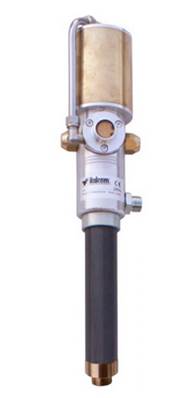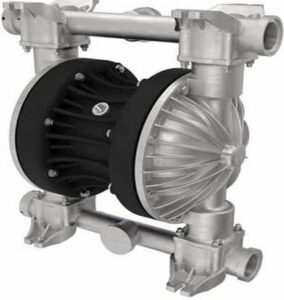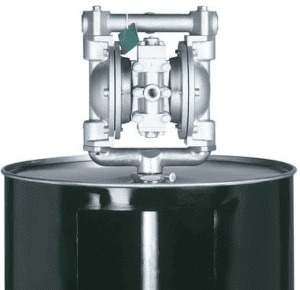Pneumatic Oil Pump
What is a pneumatic oil pump?
A pneumatic oil pump is a particular type of pump that uses the force of compressed air to create a mechanical effect that helps to manipulate the movement of oil through pipelines. A pneumatic oil pump generates amplified mechanical force by pressuring air or inert gases, which translates into a high-power source. The pneumatic oil pump consists of a double-piston system with an air-tight chamber filled with compressed gas separating the two pistons. The Pneumatic oil pump is ideal for moving low-viscosity fluids, including motor oil, old waste oil, antifreeze, transmission oil, ATF oil, and other liquids with similar properties. Pneumatic oil pump manufacturers design the units to be either wall-mounted or placed directly on the drum or tank. With the help of unique accessories, the pump can be engineered to cater to various applications. The pneumatic oil pump can deliver oil at a high flow rate of 48 liters per minute but for a short distance.

Figure: Showing the configuration of a pneumatic oil pump
Components of a pneumatic oil pump
Compressor
A pneumatic oil pump uses a compressor to raise air or gas pressure by decreasing its volume. The compressor is an electrical or gas-powered pump that helps to compress air to a higher PSI. It connects to an air storage tank which stores the air before it is released to the pneumatic track.
Check valve
A check valve is a one-way valve found in the pipe that connects the compressor and the expansion tank. It allows the compressed air to accumulate in the expansion tank while stopping it from returning to the compressor.
Pressure gauge and pressure regulator
The pressure gauge is a mechanical device that forces air into the pneumatic track. The pressure regulator is an electromechanical device that allows the operator or the computer system to check and set the air pressure in the compressor.
Actuator
The actuator is the component that performs the hard work of displacing fluid within a pneumatic oil pump. Pistons and cylinders are the most common type of actuators. When the compressed air is released into the cylinder, the piston moves forward, displacing oil.
Storage tank
The storage tank also called the buffer tank, acts as an auxiliary storage unit for the compressed air that comes from the compressors. It contains compressed air with high PSI for the pneumatic actuator. In addition, it prevents the occurrence of erratic air fluctuation inside the actuator, which helps to maximize shut-off timing in the compressor cycle.
Feed lines
These are hoses that carry compressed air within the pneumatic systems. They are usually of large diameter to allow a faster flow of compressed air and eliminate the need for airflow backup.
Strainer
Is a component used for filtering out solid particles that may be contained in the oil.
How does a pneumatic oil pump work?
The working principle of a pneumatic oil pump focuses on using a continuous supply of compressed air or inert gases to generate a large amount of power that helps to control and transfer fluid through pipelines. The pump uses two pistons that separate through an air-tight chamber loaded with compressed air or gas. One piston has a much smaller diameter than the other piston. The compressed gas acts on the larger piston exerting external pressure, which is transmitted to the fluid or gas chamber inside the intermediate chamber. As a result, the smaller diameter piston receives a higher magnitude force, which converts into stronger mechanical action. Due to the enormous force acting on the smaller piston from the larger one, it generates extreme pressure, exerts tremendous force on the fluid, and moves it to the designated location.

Figure: Working of a pneumatic oil pump
Types of pneumatic oil pumps
Pneumatic diaphragm pump
A pneumatic diaphragm oil pump utilizes a piston mechanism to move the fluids through a cylindrical chamber. This system functions with the help of pneumatic, hydraulic, electric, or steam drives.
Figure: Pneumatic diaphragm oil pump.
Explosion-proof Stainless steel pneumatic oil pump
This pump features a fully stainless-steel construction and is configured with an explosion-proof structure to prevent vapors from igniting and causing the explosion of the pumped fluid. It is suitable for service stations and oil changes, car dealerships, transport companies, and general industries. This pump is energy-saving, environmentally friendly, and durable.
Pneumatic oil pump with a drum
This pneumatic oil pump is configured with a drum and heavy-duty trolly. It is used to dispense hydraulic oil from supply containers and suits industries with hydraulic systems, vehicle dealers, and other segments. It offers the outstanding befits of allowing more autonomy in the operation and control of consumption.
Figure: Pneumatic oil pump with a drum.
Applications of pneumatic oil pumps
Pneumatic oil pump manufacturers create the pumps to cater to various applications in oil and gas production and other industries like food processing, fertilizer, pulp, and paper mills. Typical uses of the pump include:
- Pneumatic oil pumps are widely used to transfer oil in oil and gas production
- They are used for lifting and jacking.
- They are used in industries that have hydraulic systems.
- They are used for moving low-viscosity fluids such as motor oil, transmission oil, and antifreeze for a short distance, e.g., transferring from one container to another.
- They are used to circulate engine oil, synthetic oil, hydraulic oil, gear oil, and automatic transmission fluid.
- They are used to fill stationary plants with a maximum flow rate of 48 liters per minute.
Advantages of a pneumatic oil pump
- The pneumatic oil pump has high reliability and durability. The elements of pneumatic systems are highly durable and robust.
- It has high efficiency. It compresses an unlimited amount of atmosphere to generate pressurized air. After the pumping process, the compressed air can be released directly into the air without any further procedure.
- It is environmentally friendly. The pneumatic pump does not produce any harmful substances during operation. It is thus perfect for environments requiring a high level of hygiene, e.g., production line integrated circuits.
- It has fewer repairs and less downtime.
- It has a simple and compact structure with fewer moving parts.
- It has high adaptability to harsh surroundings because pressurized air is less prone to a corrosive environment, dust, and high temperature.
- It offers a simple choice of speed and pressure. The oscillating and rectilinear movement of the pneumatic oil pump is easy to set and almost unlimited.
- It is safe to operate. A pneumatic system is safer than an electrical system as it can work in an explosive environment without the risk of explosion, fire, or harm to the operator. Contrary to the pump electric oil pump, the pneumatic oil pump does not burn out during overloaded conditions.
Disadvantages of a pneumatic oil pump
- A pneumatic oil pump can generate noise when pressurized air exit the pneumatic components.
- It has a varying speed of movement. The pump piston moves at a relatively variable pace because air is easily compressible.
- A pneumatic oil pump requires processing of air before use. The compressed air must be filtered to remove dust and water vapor. Otherwise, the components of pneumatic systems would wear out rapidly due to friction.
Troubleshooting a pneumatic oil pump
The pump is not pumping
- The air compressor is not on. Make sure the air compressor is running.
- The airline is not connected to the pump air inlet. Be sure to join the airline with the pump inlet.
- The air pressure regulator fits incorrectly. Install the air regulator correctly following the pneumatic oi pump manufacturer’s guide.
- The control handle or delivery hose is obstructed. Inspect and remove any blocking material from the components.
- The air motor is defective. Disassemble the spools and inspect the O-rings and U-cups for damage or wear. Clean and regrease the air spools. Also, ensure that the inner check valve is tight.
Pump cycle but does not deliver material
- The product drum is empty. Inspect and fill the product drum
- The suction tube is cracked. Inspect and repair or replace the suction tube with another one from the pneumatic oil pump manufacturer.
- The check valve at the bottom of the suction tube is damaged. Inspect the check valve and replace it if necessary.
- The pump is not primed and thus cannot pick up any product. Perform the priming cycle to purge out ant trapped air from the system and allow the pump to generate line pressure and stall.
- In the case of a diaphragm pump, the balls are not sitting. Disassemble manifolds, clean seats, or replace balls and seats.
- The suction line is blocked. Check and remove the blockage.
Air leaks/ blow out at the exhaust
- The O-rings might be nicked or cut by a burr from an internal hole. Inspect the condition of the O-ring and replace them if necessary.
- There is a leaking spool, O-rings, or cups. Inspect the components and carry out the necessary repair. Replace them if needed.
- There is a problem with the cylinder. First, swap the spool from left to left. If the leaking remains in the exact location, inspect the cylinder and repair it.
The air motor blows air or cycles when not in use
- The air pressure regulator setting is incorrect. Excessive pressure can cause the pump to blow air or cycle. Set the pressure regulator to the value recommended by the pneumatic oil pump manufacturer.
- The bolts at the bottom of the pump air motor are loose. Tighten the bolts to the torque level specified by the pneumatic oil pump manufacturer.
- There is a loose connection on the material side of the system. Inspect for loose connections in pipe fittings, hoses, control handles, and shut-off valves and tighten.
The pump cycles slow
- The fluid viscosity is too high. Match the pump with the application requirement. Increase pump size, increase pipe diameter
- The delivery hose is blocked. Inspect and clean the delivery hose.
Pump stalls
- The air is dirty and contaminated with oil or condensation. Measure the pressure using the pressure gauge on the pump during operation. Recheck all fittings if the pressure is lower than the pneumatic oil pump manufacturer’s design pressure. Fitting snap is responsible for nearly all pump stalls.
- The distributor is faulty. Inspect and replace the distributor if necessary.
- Faulty pump stopping steps. Ensure the pump-stopping procedure is correct according to the pneumatic oil pump manufacturer’s guide.
The pump has an insufficient capacity
- The intake hose is poorly connected. Check and correct the intake hose connection.
- There is insufficient airflow. Inspect the pressure of air during pump operation. Work on all pipe fittings if it is lower than the supply pressure.
- The pumped fluid is too viscous. Ensure the pipes are large enough and meet the pneumatic oil pump specifications. Also, increase the pump size and reduce the pump speed.
Summary
A pneumatic oil pump uses compressed air to create a mechanical effect that helps control and transfer oil through pipelines. It generates amplified mechanical force by compressing air or inert gases, which translates into a high-power source. The pneumatic oil pump consists of a double-piston system with an air-tight chamber filed with compressed gas separating the two pistons. Pneumatic oil pump manufacturers configure the pumps to be either wall-mounted or placed directly on the drum or tank. They are also available in various configurations, such as pneumatic diaphragm oil pumps and explosion-proof stainless steel pneumatic oil pumps. Some types come with a drum and heavy-duty trolly. Pneumatic oil pumps are ideal for transferring low-viscosity fluids in oil and gas production and food processing, fertilizer, paper, and pulp industries. Generally, these edge-cutting devices are environmentally friendly, safe to operate, and have fewer repairs and less downtime. However, pneumatic oil pumps may produce noise as pressurized air exits the pneumatic components.


